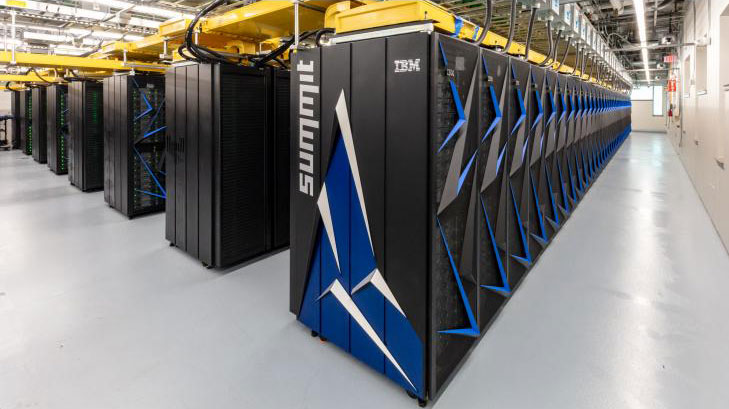US Dept of Energy IBM / Nvidia-powered Summit Supercomputer puts China’s Sunway TaihuLight to shame

2018 is the year of supercomputing giants going toe-to-toe with each other A few weeks ago AMD’s 32 Core Ryzen CPU showed Intel “how it’s done”, and last Friday the US Department of Energy unveiled Summit, the most powerful supercomputer in the world.
Eerily reminiscent of “The Machine”, the all-seeing, artificially intelligent fictional supercomputer from the TV show “Person of Interest”, Summit’s architecture and sheer size flyes past any stretch of the imagination, as the hardware itself is comprised of 4,608 servers that extend through the size of two tennis courts, housing more than 9,000 22-core IBM Power9 CPUs, and 27,000 NVIDIA Tesla V100 GPUs.
Summit is clearly not something you can just order online, and carry around in a briefcase, as it requires 4000 gallons of water per minutes just to keep it at a working temperature, considering that its power requirements are the same as powering a city the size of Palm Springs.
It goes without saying that Summit’s performance justify the massive overhead. Summit is capable of running at 200 Petaflops, which, for the rest of us, means 200 quadrillion calculations per second. A better analogy would be that it would take a regular desktop computer 30 years to solve problem that would take one second for Summit to solve.
China has maintained supremacy of supercomputing for five years straight, with Sunway TaihuLight supercomputer, running at 93 Petaflops capacity, until USDoE upgraded its Oakridge facilities to replace its previous record holder, Titan, with Summit.
The type of operations Summit is designed for, include deep learning and machine learning, which means running calculations to gather a better understanding of climate change, health, physics, and other crucial areas where there is a call for a deeper insight.
An important achievement is Summit’s successful completion of the first exascale operation, a type of scientific calculation that requires one billion billion (x2 not a typo) calculations per second, otherwise known as Exaop. Summit flew past that speed by running at 3.3 Exaops, using mixed-precision calculations.
Mixed precision uses NVIDIA Tesla V100 GPU clusters to carry on operations, by applying a measure of flexibility to its calculations, to reach faster results.
Scientists will also use Summit to analyze the light radiation from exploding stars, and gather information about how gold and other minerals more through the universe, as well as important health research such as understanding Alzheimer’s disease, heart disease, and addiction. Oak Ridge biologist Dan Jacobson went on record saying that “Summit is enabling a whole new range of science that was simply not possible before it arrived.”
Finally, Summit will also be used to research new materials that may allow for the design of revolutionary processors flying directly in the face of Moore’s law. If, or when new molecular structures are found and synthesized, the world of computing, from industries to consumers, may change radically with devices that will not only be faster and more powerful, but also packed with AI cores capable of deep-learning and machine learning tasks.